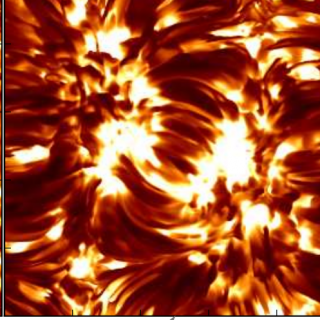Bibcode
Díaz Baso, C. J.; Asensio Ramos, A.
Referencia bibliográfica
Astronomy and Astrophysics, Volume 614, id.A5, 13 pp.
Fecha de publicación:
6
2018
Revista
Número de citas
57
Número de citas referidas
52
Descripción
Context. The Helioseismic and Magnetic Imager (HMI) provides continuum
images and magnetograms with a cadence better than one per minute. It
has been continuously observing the Sun 24 h a day for the past 7 yr.
The trade-off between full disk observations and spatial resolution
means that HMI is not adequate for analyzing the smallest-scale events
in the solar atmosphere. Aims: Our aim is to develop a new method
to enhance HMI data, simultaneously deconvolving and super-resolving
images and magnetograms. The resulting images will mimic observations
with a diffraction-limited telescope twice the diameter of HMI.
Methods: Our method, which we call Enhance, is based on two deep, fully
convolutional neural networks that input patches of HMI observations and
output deconvolved and super-resolved data. The neural networks are
trained on synthetic data obtained from simulations of the emergence of
solar active regions. Results: We have obtained deconvolved and
super-resolved HMI images. To solve this ill-defined problem with
infinite solutions we have used a neural network approach to add prior
information from the simulations. We test Enhance against Hinode data
that has been degraded to a 28 cm diameter telescope showing very good
consistency. The code is open source.
Proyectos relacionados

Magnestismo Solar y Estelar
Los campos magnéticos son uno de los ingredientes fundamentales en la formación de estrellas y su evolución. En el nacimiento de una estrella, los campos magnéticos llegan a frenar su rotación durante el colapso de la nube molecular, y en el fin de la vida de una estrella, el magnetismo puede ser clave en la forma en la que se pierden las capas
Tobías
Felipe García

Magnetismo, Polarización y Transferencia Radiativa en Astrofísica
Los campos magnéticos están presentes en todos los plasmas astrofísicos y controlan la mayor parte de la variabilidad que se observa en el Universo a escalas temporales intermedias. Se encuentran en estrellas, a lo largo de todo el diagrama de Hertzsprung-Russell, en galaxias, e incluso quizás en el medio intergaláctico. La polarización de la luz
Ernest
Alsina Ballester